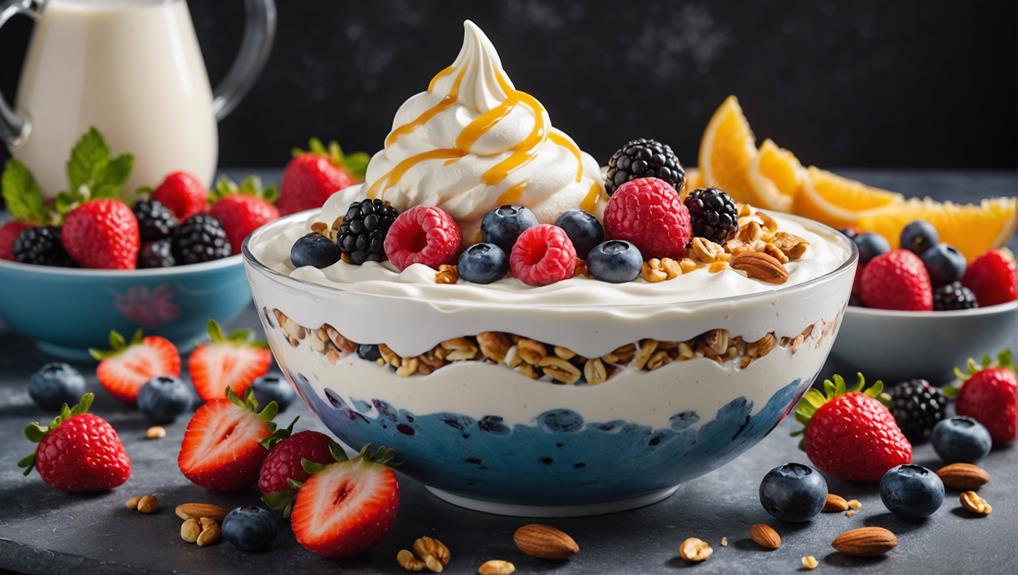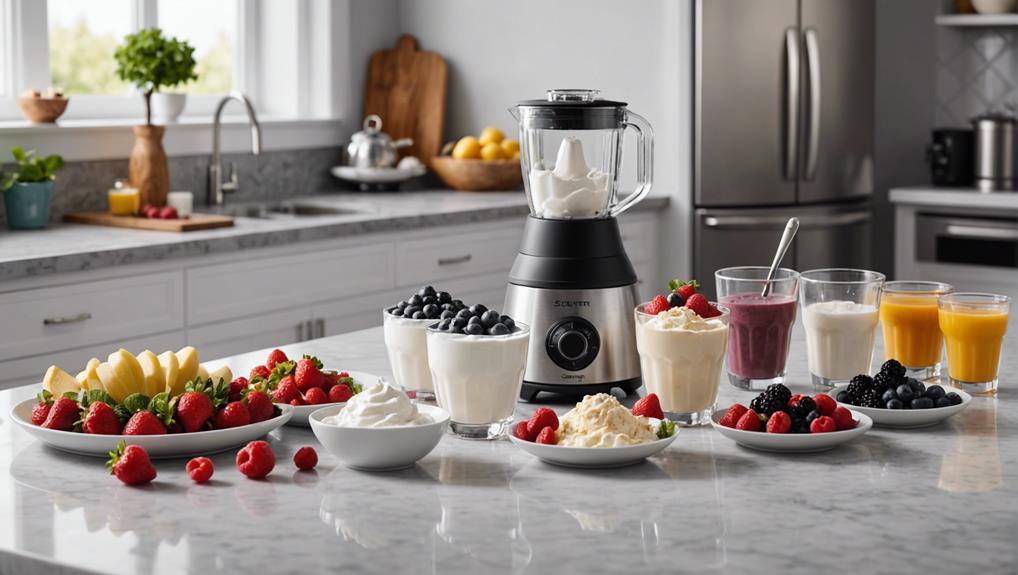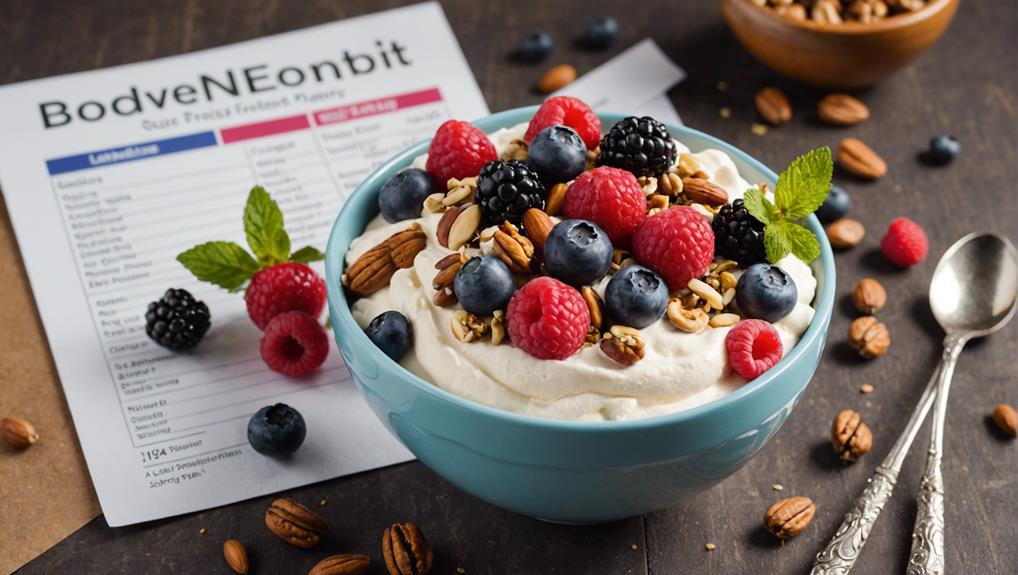High-protein frozen yogurt is a nutritious option that supports muscle recovery and growth while promoting satiety for weight management. Made with quality ingredients like Greek yogurt and protein powders, it provides approximately 15-20 grams of protein per serving. Additionally, incorporating fruits, nuts, and low-calorie sweeteners like Stevia can enhance its nutritional value. Texture can be improved with gums and pectins, ensuring a creamy consistency. Storing in airtight containers prevents freezer burn and preserves taste. For those looking to explore diverse flavors and additional health benefits, there are many creative mix-ins and topping options to explore.
Key Takeaways
- High-protein frozen yogurt supports muscle recovery and growth with 15-20 grams of protein per serving.
- Greek yogurt and protein powders are essential ingredients for creating high-protein frozen yogurt.
- Sweeteners like honey, stevia, and monk fruit enhance taste without adding excessive calories.
- Incorporate nuts, seeds, and fruits for added texture, flavor, and nutritional benefits.
- Proper storage in airtight containers prevents freezer burn and maintains flavor integrity.
Benefits of High-Protein Frozen Yogurt

High-protein frozen yogurt offers a nutritious dessert option that supports muscle recovery and growth due to its high protein content. This frozen treat serves as an excellent source of protein, which is essential for repairing and building muscle tissue, especially after physical activities. Including high-protein frozen yogurt into a balanced diet can be particularly beneficial for athletes and individuals engaged in regular exercise routines.
Moreover, the high protein content in this dessert can aid in weight management by promoting satiety and reducing overall calorie intake. Protein is known to be more satiating than carbohydrates or fats, making high-protein frozen yogurt an effective tool in curbing hunger and preventing overeating. Additionally, this versatile snack allows for a variety of recipe modifications, enabling customization to meet individual dietary preferences and nutritional needs.
High-protein frozen yogurt is not only a delectable way to increase protein intake but also a practical and enjoyable method to enhance overall nutrition. Its adaptability in recipes, ranging from simple vanilla to more elaborate combinations, ensures that it can fit seamlessly into diverse dietary plans. Therefore, incorporating high-protein frozen yogurt into one's diet can deliver both health benefits and culinary pleasure.
Essential Ingredients
When crafting high-protein frozen yogurt, the selection of quality protein sources such as Greek yogurt and protein powders is crucial to guarantee the best nutritional value. Sweeteners like honey or maple syrup are used not only to balance the yogurt's natural tartness but also to maintain a healthier profile compared to refined sugars. Additionally, incorporating nuts, seeds, and fruit can enhance both the texture and flavor, providing a more satisfying and nutrient-rich treat.
Quality Protein Sources
Utilizing quality protein sources like Greek yogurt, protein powder, and dairy-free alternatives is essential for crafting nutrient-dense high-protein frozen yogurt. Greek yogurt is particularly advantageous due to its creamy texture and high protein content, typically offering around 10 grams of protein per serving. This makes it a popular choice for creating a satisfying and nutritious frozen treat.
In addition to Greek yogurt, incorporating protein powder can greatly elevate the protein profile of the frozen yogurt. Options such as whey protein powder or plant-based alternatives like pea or soy protein provide not only additional protein but also essential amino acids necessary for muscle recovery and overall health. The versatility of protein powders allows for customized nutritional profiles tailored to individual dietary needs and preferences.
For those with dairy sensitivities or preferences, dairy-free yogurt options, such as those made from coconut or almond milk, serve as excellent alternatives. These plant-based yogurts can still deliver a substantial protein boost when paired with protein powders, making the frozen yogurt both inclusive and nutritious. By incorporating these quality protein sources, high-protein frozen yogurt can effectively support satiety and muscle health, making it a valuable addition to a balanced diet.
Sweeteners and Flavors
Incorporating the right sweeteners and flavors is crucial for enhancing the taste and nutritional profile of high-protein frozen yogurt. Choosing appropriate sweeteners and flavorings not only improves palatability but also guarantees that the final product aligns with health and dietary goals. Utilizing natural and low-calorie sweeteners can assist in maintaining a balanced nutritional profile without sacrificing taste.
Popular sweeteners and flavors include:
- Stevia and Erythritol: These sugar substitutes are low in calories and do not spike blood sugar levels, making them ideal for health-conscious consumers.
- Monk Fruit Extract: Another low-calorie sweetener, monk fruit extract provides a natural sweetness without the aftertaste often associated with artificial sweeteners.
- Vanilla and Chocolate: Classic flavors like vanilla and chocolate offer universal appeal, enhancing the creamy texture and taste of high-protein frozen yogurt.
- Fruit Flavors: Strawberries, mangoes, and other fruits can be pureed and added for a natural, vitamin-rich burst of flavor.
- Nut Flavors: Almond and peanut flavors can contribute a rich, satisfying taste while adding nutritional benefits such as healthy fats and additional protein.
Balancing sweetness and flavor intensity is the key to creating a satisfying and enjoyable high-protein frozen yogurt recipe, allowing for innovative and healthful dessert options.
Texture Enhancers
Achieving the ideal texture in high-protein frozen yogurt involves the strategic use of texture enhancers, which are pivotal for preventing ice crystal formation and ensuring a creamy, smooth consistency. Guar gum, xanthan gum, pectin, emulsifiers like lecithin, and inulin are essential ingredients that contribute to these desirable qualities.
Guar gum is a widely-used texture enhancer that effectively prevents ice crystal formation, thereby maintaining a smooth texture. Xanthan gum complements this by providing stability and enhancing mouthfeel. Pectin, a natural thickening agent, also plays a significant role in preventing ice crystallization, offering an additional layer of texture enhancement. Emulsifiers such as lecithin ensure a uniform texture by binding water and fat molecules, preventing separation. Finally, inulin not only improves texture but also increases fiber content, contributing to a creamier mouthfeel.
Here is a comparative table detailing the functions of these texture enhancers:
| Texture Enhancer | Function | Additional Benefits |
|---|---|---|
| Guar Gum | Prevents ice crystals | Creamy consistency |
| Xanthan Gum | Stability & mouthfeel | Improved texture |
| Pectin | Thickening agent | Natural ingredient |
| Lecithin | Binds water & fat | Uniform texture |
| Inulin | Fiber content | Prebiotic benefits |
These texture enhancers collectively make sure that high-protein frozen yogurt remains smooth, creamy, and nutritionally beneficial.
Step-by-Step Instructions

Begin by blending together 2 cups of Greek yogurt with one scoop of protein powder, making sure a smooth and consistent mixture. This initial blending step is important to achieve an even distribution of protein throughout the yogurt, which contributes to both the texture and nutritional profile of the final product.
To enhance flavor and nutrient content, consider these additions:
- Sweeteners: Natural options like honey or maple syrup can be mixed in.
- Flavorings: Vanilla extract or cocoa powder for added depth.
- Fruits: Fresh or frozen berries, banana slices, or mango chunks.
- Nuts: Chopped almonds, walnuts, or pecans for a crunchy texture.
- Chocolate Chips: Dark chocolate chips for a hint of indulgence.
Once you have your desired mixture, transfer it to a freezer-safe container. Freeze the mixture until it becomes frozen solid, a process that may take several hours. To make sure a creamy consistency and prevent large ice crystals from forming, it is advisable to stir the mixture periodically during freezing. This step enhances the texture, making your high-protein frozen yogurt smoother and more enjoyable.
Tips for Perfect Texture
Maintaining a creamy and smooth texture in your high-protein frozen yogurt is crucial for both enjoyment and consistency, and can be achieved by periodically stirring the mixture during the freezing process. Stirring every 30 minutes is recommended to prevent the formation of large ice crystals, which can negatively affect the texture. This technique guarantees the frozen yogurt maintains a desirable soft-serve consistency, closely mimicking the quality of store-bought varieties.
Freezing the mixture in intervals helps to integrate air and break up ice crystals, contributing to a smoother and creamier final product. This process is particularly important for high-protein frozen yogurt, as protein can sometimes result in a denser texture if not properly managed. Adjusting the freezing time and stirring frequency allows for customization according to personal preference, providing flexibility in achieving the perfect consistency.
Incorporating these tips will not only enhance the mouthfeel but also make sure that the frozen yogurt remains a delicious and nutritious high-protein dessert or snack option. By following these guidelines, you can enjoy the creamy texture of homemade frozen yogurt that rivals any commercial product.
Flavor Variations

Exploring various flavor variations can greatly enhance the nutritional profile and enjoyment of your high-protein frozen yogurt. By incorporating diverse ingredients, you can achieve a balance of taste and health benefits, creating a versatile treat suitable for various dietary needs.
Incorporating different types of whey protein, such as chocolate or vanilla, provides a robust base flavor while boosting protein content. Almond milk can be used as a creamy, dairy-free alternative that adds a subtle nutty flavor and essential nutrients like vitamin E. To elevate the texture and appeal, consider these mix-ins:
- Chocolate chips: Adds a delightful crunch and rich flavor to complement the yogurt.
- Fresh or frozen fruits: Berries, mango, or banana for natural sweetness and additional vitamins.
- Nuts and seeds: Almonds or chia seeds for extra protein and healthy fats.
- Granola: Introduces a wholesome, crunchy element, enhancing the nutritional value.
- Natural sweeteners: A drizzle of honey or maple syrup provides a touch of sweetness without significant sugar overload.
Each of these variations not only enhances the flavor but also adds distinct nutritional benefits, making your high-protein frozen yogurt a well-rounded, delicious, and health-conscious choice.
Topping Ideas
Improving your high-protein frozen yogurt with nutrient-dense toppings can greatly enhance its health benefits and overall appeal. Fresh fruit toppings like berries, bananas, and mangoes not only add natural sweetness but also provide essential vitamins and antioxidants. Nut and seed toppings, such as almonds, walnuts, chia seeds, and pumpkin seeds, offer a crunchy texture along with healthy fats and protein.
Drizzling a small amount of honey or maple syrup can enhance sweetness without compromising the protein content. Granola or crushed whole-grain cereals contribute a satisfying crunch and additional fiber, promoting digestive health. For a touch of indulgence, sprinkle dark chocolate chips, cocoa nibs, or shredded coconut, which can provide a rich flavor while maintaining the yogurt's protein profile.
Below is a table summarizing some nutrient-focused toppings and their benefits:
| Topping | Nutritional Benefits |
|---|---|
| Fresh Berries | High in antioxidants and vitamins |
| Almonds | Provide healthy fats and additional protein |
| Granola | Adds fiber and a satisfying crunch |
| Honey | Natural sweetener with antibacterial properties |
| Dark Chocolate | Rich in antioxidants and adds a touch of indulgence |
Incorporating these toppings can transform your high-protein frozen yogurt into a nutrient-packed dessert or snack, enhancing both its flavor and health benefits.
Nutritional Information

High-protein frozen yogurt is a nutrient-dense dessert that typically offers 15-20 grams of protein per serving, making it an excellent choice for those seeking to boost their protein intake. The high protein content is primarily derived from ingredients such as Greek yogurt and protein powder, both of which are known for their significant protein contributions. Greek yogurt provides a rich, creamy base while adding essential nutrients such as calcium and probiotics, which support gut health. Protein powder, often used to further elevate the protein content, can be customized to fit dietary preferences, including whey, soy, or plant-based options.
Nutritionally, high-protein frozen yogurt stands out for several reasons:
- Muscle Recovery: Its protein content supports muscle recovery and growth, especially beneficial post-workout.
- Satiety: Protein increases feelings of fullness, helping to manage appetite and reduce overall caloric intake.
- Bone Health: Greek yogurt contributes calcium, which is important for maintaining strong bones.
- Digestive Health: Probiotics in Greek yogurt aid in digestive health and enhance the gut microbiome.
- Low Fat Options: Many high-protein frozen yogurts are available in low-fat versions, making them suitable for those monitoring their fat intake.
This nutrient-rich dessert not only satisfies sweet cravings but also aligns with health and fitness goals.
Storage Tips
Proper storage of high-protein frozen yogurt is essential to preserving its nutritional integrity and taste. Utilizing an airtight container and maintaining an ideal temperature range in the freezer can greatly reduce the risk of freezer burn, thereby ensuring the yogurt retains its creamy texture and protein content. Additionally, minimizing temperature fluctuations by avoiding repeated thawing and refreezing will help maintain its quality over time.
Optimal Temperature Range
Maintaining high-protein frozen yogurt at a temperature range of 0°F to -10°F (-18°C to -23°C) is essential for preserving its ideal texture and taste. Adhering to this specific freezer temperature range guarantees that the frozen yogurt retains its creamy consistency and nutritional integrity over time. Deviating from these storage guidelines can lead to undesirable changes in texture, such as crystallization, and potential nutrient degradation.
To maximize the quality of your high-protein frozen yogurt, consider the following storage tips:
- Avoid storing frozen yogurt in the freezer door: Fluctuating temperatures in the door can compromise consistency.
- Thaw in the refrigerator before serving: Allow approximately 30 minutes for a creamier texture.
- Consume within 1-2 months: Prolonged storage can impact both taste and texture.
- Use properly sealed containers or freezer bags: This helps prevent freezer burn and maintains freshness.
- Regularly check freezer temperature: Ensure it stays within the ideal range for best results.
Airtight Container Benefits
Utilizing airtight containers for storing frozen yogurt greatly decreases the risk of freezer burn, thereby preserving its nutritional quality and creamy texture. Ensuring that your high-protein frozen yogurt is kept in an airtight container is essential for maintaining its freshness. This form of storage not only prevents the yogurt from absorbing odors or flavors from other foods in the freezer but also minimizes the formation of ice crystals. Consequently, this helps in retaining the smooth consistency and taste of the frozen yogurt over time.
Moreover, airtight containers make it easier to organize and maximize storage space in the freezer. The following table highlights key benefits of using airtight containers for storage:
| Benefit | Description |
|---|---|
| Prevents Freezer Burn | Reduces exposure to air, maintaining nutritional quality and texture. |
| Odor and Flavor Protection | Prevents the yogurt from absorbing unwanted smells and tastes from other foods. |
| Maintains Creamy Texture | Minimizes ice crystal formation, ensuring smooth consistency. |
| Efficient Storage | Facilitates easier stacking and organization, optimizing freezer space. |
Avoiding Freezer Burn
In addition to using airtight containers, there are several other strategies that can be employed to avoid freezer burn and guarantee your high-protein frozen yogurt retains its peak nutritional quality and taste. Proper storage techniques are essential for maintaining both the flavor and nutritional integrity of your frozen yogurt, particularly when it is rich in protein.
- Place in the Coldest Part of the Freezer: Positioning the frozen yogurt in the chilliest section minimizes the risk of partial thawing and refreezing, which can compromise texture and quality.
- Minimize Freezer Openings: Frequent opening and closing of the freezer door lead to temperature fluctuations, increasing the risk of freezer burn. Consistency in temperature is key.
- Consume Within 1-2 Weeks: For best taste and texture, it is advisable to consume high-protein frozen yogurt within one to two weeks of storage.
- Seal Properly: Ensure the airtight container is tightly sealed to prevent air exposure, which is a primary cause of freezer burn.
- Avoid Overfilling the Freezer: Overcrowding can restrict airflow and lead to uneven freezing, which may cause freezer burn in certain areas of the frozen yogurt.
Frequently Asked Questions

Frequently asked questions about high-protein frozen yogurt often center around its nutritional benefits, preparation methods, and customization options. One common inquiry is about the ingredients used to enhance protein content. Typically, Greek yogurt and protein powder are combined to create a high-protein frozen yogurt, leveraging the naturally high protein content of Greek yogurt and the added boost from protein powder. This combination not only increases the protein content but also contributes to a creamy texture and rich flavor.
Another frequently asked question concerns the nutritional advantages of this dessert. High-protein frozen yogurt can serve as a nutritious alternative to traditional ice cream, providing essential amino acids that support muscle growth and repair. Additionally, it is lower in fat and calories compared to many commercial ice creams, making it a healthier choice for those monitoring their diet.
Customization is another topic of interest. Many wonder how to personalize their frozen yogurt. This dessert can be easily modified with various flavors and mix-ins, such as fresh fruit, nuts, or dark chocolate chips, to cater to individual taste preferences while maintaining its nutritional profile. Understanding these aspects can help consumers make informed choices about incorporating high-protein frozen yogurt into their diet.
Frequently Asked Questions
Is Frozen Yogurt High in Protein?
Frozen yogurt can be high in protein, notably when made with Greek yogurt, plant-based protein, or protein supplements. These ingredients greatly enhance its protein content, making it a nutrient-dense, health-oriented option for increasing daily protein intake.
Can You Freeze High Protein Yogurt?
Freezing high-protein yogurt is possible, ensuring protein preservation. The freezing process maintains nutritional benefits while creating a creamy yogurt texture. For best results, stir or blend post-freezing to achieve desired consistency.
What Kind of Frozen Yogurt Is Healthiest?
The healthiest frozen yogurt is typically Greek yogurt-based, as it offers higher protein and probiotic benefits. Select options with minimal sugar content and natural sweeteners to maximize health benefits while maintaining nutrient density and digestive health.
Is Frozen Yogurt Healthier Than Ice Cream?
Like a balanced diet, frozen yogurt often surpasses ice cream in health metrics due to its lower calorie count, reduced fat percentage, and potential probiotic benefits. However, be mindful of sugar content, which can vary greatly.
Conclusion
To sum up, high-protein frozen yogurt offers a nutritious and delectable alternative to traditional desserts. A notable statistic reveals that consuming a serving of high-protein frozen yogurt can provide up to 20 grams of protein, which constitutes around 40% of the recommended daily intake for an average adult. This makes high-protein frozen yogurt not only a tasty treat but also a valuable addition to a balanced diet, supporting muscle repair and overall health.







